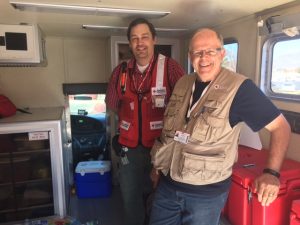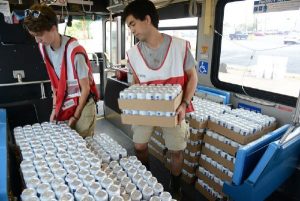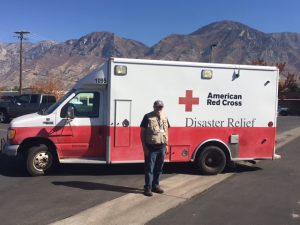Editor’s note: this story pairs with “Stories of relief from Hurricane Harvey”
The videos were devastating: splintered trees, houses in ruins, piles of trash on the curb as far as the camera lens could see. Three major weather disasters struck the U.S. within a month earlier this year, and the damage is immense.
The images returned again after Hurricane Harvey struck Houston, as Florida streets were inundated with water and houses flooded to the rooftop from Hurricane Irma’s storm surge. In Puerto Rico, there was not much left standing for a camera to focus on. Hurricane Maria didn’t flood, it destroyed.
Under these shocking news images, a line of text was ubiquitous for viewers: TEXT HARVEY TO 90999 TO DONATE $10 TO RED CROSS.
The Red Cross placed 21st on Forbes list of the Largest 100 charities in the US but remains one of the most recognizable names in disaster relief efforts. When the hurricanes hit, the Red Cross was one of the first responders on the ground.
Volunteers in red and white poured into flooded areas and millions of dollars in donations flooded the organization’s coffers. American Red Cross reported receiving more than $400 million in donations and pledges for hurricane relief, according to a report compiled by USA Today on Sept. 2.
But it’s only a small dent in the overall price tag from the 2017 hurricane season. Harvey and Irma are estimated to have caused more than $200 billion in damages according to Moody Analytics. A report from IHS compiled by USA Today states that it will take between $40 and $80 billion to restore Puerto Rico, which was devastated by Hurricane Maria.
The Red Cross has been managing funds and distributing relief since 1881, and officials say they know exactly how to make a difference.
In early August 2017, hundreds of Red Cross volunteers met at the UCCU Center on the Utah Valley University campus for a weeklong crisis situation drill. More than 400 cots in neat rows on the center floor transformed the building into a shelter. Emergency response vehicles, or ERVs, transported meals to the makeshift shelters, and volunteers at the UCCU Center took residents on a tour of what it would be like to stay in a Red Cross shelter during a mass crisis situation.

However, their practice would soon be put to the test as Hurricane Harvey made its way toward Texas.
“Everybody was playing, but we were all watching the news because Harvey’s coming,” said Jeff Beaty, crisis management director of the Provo Red Cross chapter. “We ended the national mass crisis exercise Thursday and Saturday and Sunday the hurricane hit. Playtime was over.”
Red Cross workers began moving resources as soon as it became apparent that Harvey was going to hit Texas hard. Beaty said that the Salt Lake ERV began making its way toward Texas immediately after the crisis exercise on August 24. Volunteers and more resources followed soon after.
“Every ERV has a GPS, and I can see every blip where there was an ERV and it was massive,” said Beaty. “In our region, we have 6 ERVs. They were all deployed either to Texas or Florida at the time.”
As water flooded the streets of Texas, generous donations flooded the Red Cross location in Provo. Beaty said phones were ringing continuously the first day and a constant flow of people brought clothing, food, and supplies to the office from as far as Price.
Residents donated their time and connections as well, according to Beaty. One resident of Provo had connections to a trucking company, and organized trucks to take shipments of donated supplies to Texas and Florida every week. Another Provo resident pulled the seats out of his car, packed it full of donated supplies and drove them to Texas himself.

“One of the most interesting was a truck driver from a local grocery store who just wanted to do something nice,” said Beaty. “He went out with a bucket and stood on a corner accepting donations for Red Cross. His efforts ended up being like $10.53, but he dumped out his bucket on the counter and said he felt like he’d done something for the victims of these hurricanes.”
Donations of money, like the $10 donated when someone texts HARVEY to 90999, allow for more flexibility in meeting the needs of victims in disasters, according to Red Cross Regional Director of Communications Rich Woodruff.
The Red Cross website says 91 percent of donations are funneled to humanitarian and disaster relief efforts and Red Cross tries to make sure the money goes where donors intend it.
“Donors can designate that (their donation) goes to a specific disaster. We honor donor intent when the money is directed to an operation. Funds will go where they are needed most, like to pay expenses with volunteers and shelters,” said Woodruff. “When you’re dealing with the hundreds of thousands required to fund big operations like that, it all counts. We can tell you what $10 goes to. It will pay for warm meals, for comfort kits with toiletry items. But we have to put it all together.”
Thousands of volunteers stepped forward to distribute the donated supplies and help with recovery in Texas, Florida, and Puerto Rico. Red Cross volunteers serve for two weeks at a time, though they can return for multiple trips. Provo resident John Fisher had a first-hand view of the devastation and the relief that comes from these donations.

“We had probably six emergency vehicles (in Houston). They were all out every day at noon and 5. In that situation if people were able to be in their home, they’d had blue tarps on their houses because their roofs were torn off,” said Fisher.
Fisher continued, “People left for several days then came back and started rebuilding their lives. In the meantime, the Red Cross has shown up with food and bulk items. Diapers and care kits and toys for children, all of those kinds of things.”
The recovery efforts from these hurricanes will stretch for years and the response from across the country will stand as proof of how a small donation can make a difference.
“The response was broad from money to materials to blood,” said Beaty. “People were generous and they give.”




